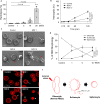MARTX toxin of Vibrio vulnificus induces RBC phosphatidylserine exposure that can contribute to thrombosis
- PMID: 35978022
- PMCID: PMC9385741
- DOI: 10.1038/s41467-022-32599-0
MARTX toxin of Vibrio vulnificus induces RBC phosphatidylserine exposure that can contribute to thrombosis
Abstract
V. vulnificus-infected patients suffer from hemolytic anemia and circulatory lesions, often accompanied by venous thrombosis. However, the pathophysiological mechanism of venous thrombosis associated with V. vulnificus infection remains largely unknown. Herein, V. vulnificus infection at the sub-hemolytic level induced shape change of human red blood cells (RBCs) accompanied by phosphatidylserine exposure, and microvesicle generation, leading to the procoagulant activation of RBCs and ultimately, acquisition of prothrombotic activity. Of note, V. vulnificus exposed to RBCs substantially upregulated the rtxA gene encoding multifunctional autoprocessing repeats-in-toxin (MARTX) toxin. Mutant studies showed that V. vulnificus-induced RBC procoagulant activity was due to the pore forming region of the MARTX toxin causing intracellular Ca2+ influx in RBCs. In a rat venous thrombosis model triggered by tissue factor and stasis, the V. vulnificus wild type increased thrombosis while the ΔrtxA mutant failed to increase thrombosis, confirming that V. vulnificus induces thrombosis through the procoagulant activation of RBCs via the mediation of the MARTX toxin.
© 2022. The Author(s).
Conflict of interest statement
The authors declare no competing interests.
Figures





Similar articles
-
A MARTX Toxin rtxA Gene Is Controlled by Host Environmental Signals through a CRP-Coordinated Regulatory Network in Vibrio vulnificus.mBio. 2020 Jul 28;11(4):e00723-20. doi: 10.1128/mBio.00723-20. mBio. 2020. PMID: 32723914 Free PMC article.
-
Vibrio vulnificus PlpA facilitates necrotic host cell death induced by the pore forming MARTX toxin.J Microbiol. 2022 Feb;60(2):224-233. doi: 10.1007/s12275-022-1448-x. Epub 2022 Feb 1. J Microbiol. 2022. PMID: 35102528
-
MARTX Toxin-Stimulated Interplay between Human Cells and Vibrio vulnificus.mSphere. 2020 Aug 12;5(4):e00659-20. doi: 10.1128/mSphere.00659-20. mSphere. 2020. PMID: 32817457 Free PMC article.
-
Non-Repeat Segment 1 in Vibrio vulnificus MARTX toxin, which binds to biantennary N-glycans, is essential for host cell blebbing but dispensable for effector translocation.Microbiol Res. 2025 Jun;295:128108. doi: 10.1016/j.micres.2025.128108. Epub 2025 Feb 19. Microbiol Res. 2025. PMID: 39987752 Review.
-
Cross-Kingdom Activation of Vibrio Toxins by ADP-Ribosylation Factor Family GTPases.J Bacteriol. 2020 Nov 19;202(24):e00278-20. doi: 10.1128/JB.00278-20. Print 2020 Nov 19. J Bacteriol. 2020. PMID: 32900828 Free PMC article. Review.
Cited by
-
An Overview of Clinical Manifestations of Dermatological Disorders in Intensive Care Units: What Should Intensivists Be Aware of?Diagnostics (Basel). 2023 Mar 29;13(7):1290. doi: 10.3390/diagnostics13071290. Diagnostics (Basel). 2023. PMID: 37046508 Free PMC article. Review.
-
Structural basis of the activation of MARTX cysteine protease domain from Vibrio vulnificus.PLoS One. 2024 Aug 2;19(8):e0307512. doi: 10.1371/journal.pone.0307512. eCollection 2024. PLoS One. 2024. PMID: 39093838 Free PMC article.
-
Crucial roles of red blood cells and platelets in whole blood thrombin generation.Blood Adv. 2023 Nov 14;7(21):6717-6731. doi: 10.1182/bloodadvances.2023010027. Blood Adv. 2023. PMID: 37648671 Free PMC article.
-
Genome-wide phenotypic profiling of transcription factors and identification of novel targets to control the virulence of Vibrio vulnificus.Nucleic Acids Res. 2025 Jan 24;53(3):gkae1238. doi: 10.1093/nar/gkae1238. Nucleic Acids Res. 2025. PMID: 39704106 Free PMC article.
-
TolCV1 inhibition by NPPB renders Vibrio vulnificus less virulent and more susceptible to antibiotics.Antimicrob Agents Chemother. 2025 Jan 31;69(1):e0050224. doi: 10.1128/aac.00502-24. Epub 2024 Dec 13. Antimicrob Agents Chemother. 2025. PMID: 39670721 Free PMC article.
References
-
- Sun, Y., Lin, Y. Z. & Chen, Z. G. An uncommon case of necrotizing fasciitis and septic shock caused by Vibrio vulnificus infection–related freshwater shrimp stung. Int. J. Low. Extrem. Wounds 1534734620973992 (2020). - PubMed
-
- Centers for Disease Control and Prevention (CDC Vibrio vulnificus infections associated with eating raw oysters–Los Angeles, 1996. MMWR. 1996;45:621–624. - PubMed
Publication types
MeSH terms
Substances
LinkOut - more resources
Full Text Sources
Medical
Miscellaneous

